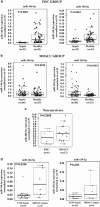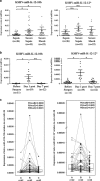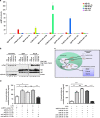Cellular and Kaposi's sarcoma-associated herpes virus microRNAs in sepsis and surgical trauma
- PMID: 25476907
- PMCID: PMC4649832
- DOI: 10.1038/cddis.2014.515
Cellular and Kaposi's sarcoma-associated herpes virus microRNAs in sepsis and surgical trauma
Abstract
Once a patient is in septic shock, survival rates drop by 7.6% for every hour of delay in antibiotic therapy. Biomarkers based on the molecular mechanism of sepsis are important for timely diagnosis and triage. Here, we study the potential roles of a panel of cellular and viral miRNAs as sepsis biomarkers. We performed genome-wide microRNA (miRNA) expression profiling in leukocytes from septic patients and nonseptic controls, combined with quantitative RT-PCR in plasmas from two cohorts of septic patients, two cohorts of nonseptic surgical patients and healthy volunteers. Enzyme-linked immunosorbent assay, miRNA transfection and chromatin immunoprecipitation were used to study the effects of Kaposi sarcoma herpes virus (KSHV) miRNAs on interleukin's secretion. Differences related to sepsis etiology were noted for plasma levels of 10 cellular and 2 KSHV miRNAs (miR-K-10b and miR-K-12-12*) between septic and nonseptic patients. All the sepsis groups had high KSHV miRNAs levels compared with controls; Afro-American patients had higher levels of KSHV-miR-K12-12* than non-Afro-American patients. Both KSHV miRNAs were increased on postoperative day 1, but returned to baseline on day 7; they acted as direct agonists of Toll-like receptor 8 (TLR8), which might explain the increased secretion of the IL-6 and IL-10. Cellular and KSHV miRNAs are differentially expressed in sepsis and early postsurgical patients and may be exploited for diagnostic and therapeutic purposes. Increased miR-K-10b and miR-K12-12* are functionally involved in sepsis as agonists of TLR8, forming a positive feedback that may lead to cytokine dysregulation.
Figures




Comment in
-
Old case, new leads: miRNA links Kaposi's sarcoma-associated herpesvirus with sepsis.Cell Death Dis. 2014 Dec 4;5(12):e1560. doi: 10.1038/cddis.2014.516. Cell Death Dis. 2014. PMID: 25476908 Free PMC article. No abstract available.
References
-
- 1Angus DC, Linde-Zwirble WT, Lidicker J, Clermont G, Carcillo J, Pinsky MR. Epidemiology of severe sepsis in the United States: analysis of incidence, outcome, and associated costs of care. Crit Care Med 2001; 29: 1303–1310. - PubMed
-
- 2Vincent JL, Sakr Y, Sprung CL, Ranieri VM, Reinhart K, Gerlach H et al. Sepsis in European intensive care units: results of the SOAP study. Crit Care Med 2006; 34: 344–353. - PubMed
-
- 3Moore LJ, McKinley BA, Turner KL, Todd SR, Sucher JF, Valdivia A et al. The epidemiology of sepsis in general surgery patients. J Trauma 2011; 70: 672–680. - PubMed
-
- 4Pinsky MR, Vincent JL, Deviere J, Alegre M, Kahn RJ, Dupont E. Serum cytokine levels in human septic shock. Relation to multiple-system organ failure and mortality. Chest 1993; 103: 565–575. - PubMed
Publication types
MeSH terms
Substances
Grants and funding
LinkOut - more resources
Full Text Sources
Other Literature Sources
Medical
Molecular Biology Databases
Miscellaneous

